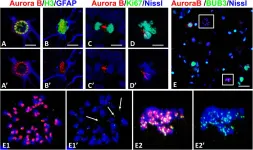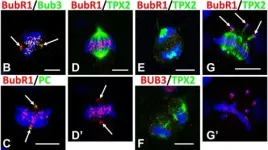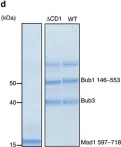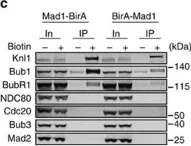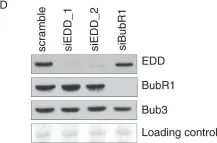Mitotic defects activate the spindle-assembly checkpoint, which inhibits the anaphase-promoting complex co-activator CDC20 to induce a prolonged cell cycle arrest1,2. Once errors are corrected, the spindle-assembly checkpoint is silenced, allowing anaphase onset to occur. However, in the presence of persistent unresolvable errors, cells can undergo 'mitotic slippage', exiting mitosis into a tetraploid G1 state and escaping the cell death that results from a prolonged arrest. The molecular logic that enables cells to balance these duelling mitotic arrest and slippage behaviours remains unclear. Here we demonstrate that human cells modulate the duration of their mitotic arrest through the presence of conserved, alternative CDC20 translational isoforms. Downstream translation initiation results in a truncated CDC20 isoform that is resistant to spindle-assembly-checkpoint-mediated inhibition and promotes mitotic exit even in the presence of mitotic perturbations. Our study supports a model in which the relative levels of CDC20 translational isoforms control the duration of mitotic arrest. During a prolonged mitotic arrest, new protein synthesis and differential CDC20 isoform turnover create a timer, with mitotic exit occurring once the truncated Met43 isoform achieves sufficient levels. Targeted molecular changes or naturally occurring cancer mutations that alter CDC20 isoform ratios or its translational control modulate mitotic arrest duration and anti-mitotic drug sensitivity, with potential implications for the diagnosis and treatment of human cancers.
© 2023. The Author(s), under exclusive licence to Springer Nature Limited.
Product Citations: 21
Alternative CDC20 translational isoforms tune mitotic arrest duration.
In Nature on 1 May 2023 by Tsang, M. J. & Cheeseman, I. M.
-
WB
-
Biochemistry and Molecular biology
-
Cell Biology
In Cell Reports on 21 September 2021 by Chen, Q., Zhang, M., et al.
Bub1 is required for the kinetochore/centromere localization of two essential mitotic kinases Plk1 and Aurora B. Surprisingly, stable depletion of Bub1 by ∼95% in human cells marginally affects whole chromosome segregation fidelity. We show that CENP-U, which is recruited to kinetochores by the CENP-P and CENP-Q subunits of the CENP-O complex, is required to prevent chromosome mis-segregation in Bub1-depleted cells. Mechanistically, Bub1 and CENP-U redundantly recruit Plk1 to kinetochores to stabilize kinetochore-microtubule attachments, thereby ensuring accurate chromosome segregation. Furthermore, unlike its budding yeast homolog, the CENP-O complex does not regulate centromeric localization of Aurora B. Consistently, depletion of Bub1 or CENP-U sensitizes cells to the inhibition of Plk1 but not Aurora B kinase activity. Taken together, our findings provide mechanistic insight into the regulation of kinetochore function, which may have implications for targeted treatment of cancer cells with mutations perturbing kinetochore recruitment of Plk1 by Bub1 or the CENP-O complex.
Copyright © 2021 The Author(s). Published by Elsevier Inc. All rights reserved.
-
Genetics
In Cell Reports on 30 March 2021 by Yatskevich, S., Kroonen, J. S., et al.
The anaphase-promoting complex/cyclosome (APC/C) is an E3 ubiquitin ligase that controls cell cycle transitions. Its regulation by the spindle assembly checkpoint (SAC) is coordinated with the attachment of sister chromatids to the mitotic spindle. APC/C SUMOylation on APC4 ensures timely anaphase onset and chromosome segregation. To understand the structural and functional consequences of APC/C SUMOylation, we reconstituted SUMOylated APC/C for electron cryo-microscopy and biochemical analyses. SUMOylation of the APC/C causes a substantial rearrangement of the WHB domain of APC/C's cullin subunit (APC2WHB). Although APC/CCdc20 SUMOylation results in a modest impact on normal APC/CCdc20 activity, repositioning APC2WHB reduces the affinity of APC/CCdc20 for the mitotic checkpoint complex (MCC), the effector of the SAC. This attenuates MCC-mediated suppression of APC/CCdc20 activity, allowing for more efficient ubiquitination of APC/CCdc20 substrates in the presence of the MCC. Thus, SUMOylation stimulates the reactivation of APC/CCdc20 when the SAC is silenced, contributing to timely anaphase onset.
Copyright © 2021 MRC Laboratory of Molecular Biology. Published by Elsevier Inc. All rights reserved.
Preprint on BioRxiv : the Preprint Server for Biology on 2 February 2021 by Chen, Q., Zhang, M., et al.
h4>SUMMARY/h4> The multi-task protein kinase Bub1 has long been considered important for chromosome alignment and spindle assembly checkpoint signaling during mitosis. However, recent studies provide surprising evidence that Bub1 may not be essential in human cells, with the underlying mechanism unknown. Here we show that Bub1 plays a redundant role with the non-essential CENP-U complex in recruiting Polo-like kinase 1 (Plk1) to the kinetochore. While disrupting either pathway of Plk1 recruitment does not affect the accuracy of whole chromosome segregation, loss of both pathways leads to a strong reduction in the kinetochore accumulation of Plk1 under a threshold level required for proper chromosome alignment and segregation. Thus, parallel recruitment of Plk1 to kinetochores by Bub1 and the CENP-U complex ensures high fidelity of mitotic chromosome segregation. This study may have implications for targeted treatment of cancer cells harboring mutations in either Bub1 or the CENP-U complex.
-
Genetics
Paradoxical mitotic exit induced by a small molecule inhibitor of APC/CCdc20.
In Nature Chemical Biology on 1 May 2020 by Richeson, K. V., Bodrug, T., et al.
The anaphase-promoting complex/cyclosome (APC/C) is a ubiquitin ligase that initiates anaphase and mitotic exit. APC/C is activated by Cdc20 and inhibited by the mitotic checkpoint complex (MCC), which delays mitotic exit when the spindle assembly checkpoint (SAC) is activated. We previously identified apcin as a small molecule ligand of Cdc20 that inhibits APC/CCdc20 and prolongs mitosis. Here we find that apcin paradoxically shortens mitosis when SAC activity is high. These opposing effects of apcin arise from targeting of a common binding site in Cdc20 required for both substrate ubiquitination and MCC-dependent APC/C inhibition. Furthermore, we found that apcin cooperates with p31comet to relieve MCC-dependent inhibition of APC/C. Apcin therefore causes either net APC/C inhibition, prolonging mitosis when SAC activity is low, or net APC/C activation, shortening mitosis when SAC activity is high, demonstrating that a small molecule can produce opposing biological effects depending on regulatory context.
-
WB
-
Cell Biology
In Acta Neuropathol Commun on 15 April 2020 by Sosunov, A., Wu, X., et al.
Fig.8.A,B,C,D,E

-
ICC-IF
-
Rattus norvegicus (Rat)
Collected and cropped from Acta Neuropathol Commun by CiteAb, provided under a CC-BY license
Image 1 of 5
In Acta Neuropathol Commun on 15 April 2020 by Sosunov, A., Wu, X., et al.
Fig.7.B,C,D,E,G

-
ICC-IF
-
Rattus norvegicus (Rat)
Collected and cropped from Acta Neuropathol Commun by CiteAb, provided under a CC-BY license
Image 1 of 5
In Nat Commun on 12 June 2017 by Zhang, G., Kruse, T., et al.
Fig.3.D

-
WB
-
Homo sapiens (Human)
Collected and cropped from Nat Commun by CiteAb, provided under a CC-BY license
Image 1 of 5
In Nat Commun on 12 June 2017 by Zhang, G., Kruse, T., et al.
Fig.3.C

-
WB
-
Homo sapiens (Human)
Collected and cropped from Nat Commun by CiteAb, provided under a CC-BY license
Image 1 of 5
In J Biol Chem on 15 May 2015 by Scialpi, F., Mellis, D., et al.
Fig.5.D

-
WB
-
Collected and cropped from J Biol Chem by CiteAb, provided under a CC-BY license
Image 1 of 5
